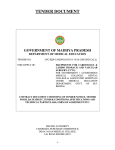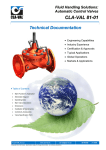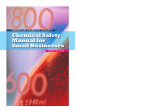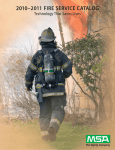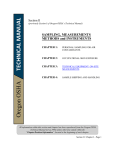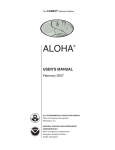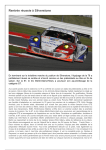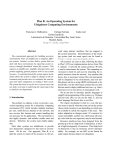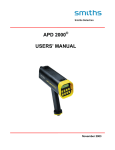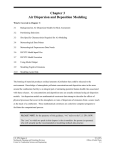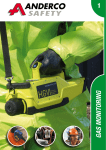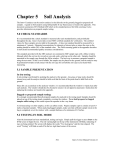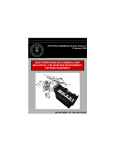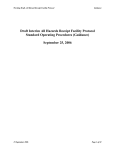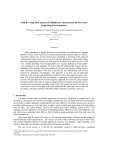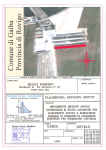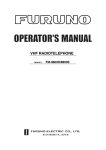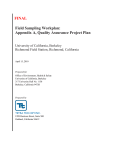Download Student Manual - Environmental Response Training Program ERTP
Transcript
United States Environmental Protection Agency Office of Solid Waste and Emergency Response (5201G) March 2012 Superfund Air Monitoring for Emergency Response Student Manual EPA-540-B-00-001 OSWER 9285.9-36 FOREWORD This manual is for reference use of students enrolled in scheduled training courses of the U.S. Environmental Protection Agency (EPA). While it will be useful to anyone who needs information on the subjects covered, it will have its greatest value as an adjunct to classroom presentations involving discussions among the students and instructional staff. This manual has been developed to provide the best available current information; however, individual instructors may provide additional material to cover special aspects of their presentations. Because of the limited availability of the manual, it should not be cited in bibliographies or other publications. References to products and manufacturers are for illustration only; they do not imply endorsement by EPA. Constructive suggestions for improvement of the content and format of the Air Monitoring for Emergency Response manual are welcome. Student Manual TABLE OF CONTENTS Title Section Orientation & Introduction 1 Air Monitoring Considerations 2 Oxygen Monitors, Combustible Gas Indicators, and Specific Chemical Monitors 3 Total Vapor Instruments 4 Exposure Limits and Action Guides 5 Field Analytical Technologies 6 Chemical Warfare Agent Detection 7 Air Dispersion Modeling 8 Air Dispersion Computer-Model Demonstration 9 Air Sample Collection 10 Acronyms and Abbreviations 11 Orientation & Introduction AIR MONITORING FOR EMERGENCY RESPONSE presented by Tetra Tech NUS, Inc. for the U.S. Environmental Protection Agency's Environmental Response Team Contract Number EP-W-08-054 ENVIRONMENTAL RESPONSE TRAINING PROGRAM (ERTP) U.S. EPA United States Environmental Protection Agency OSWER Office of Solid Waste and Emergency Response (Superfund) OSRTI Office of Superfund Remediation and Technology Innovation ERT Environmental Response Team ERTP TRAINING COURSES • Are offered tuition-free for environmental and response personnel from federal, state, and local agencies • Vary in length from one to five days • Are conducted at locations throughout the United States 1 AIR MONITORING FOR EMERGENCY RESPONSE (R 10-11) Orientation & Introduction ERTP TRAINING COURSES Course Descriptions, Class Schedules, and Registration Information are available at: • www.trainex.org • www.ertpvu.org COURSE OBJECTIVES • Properly use the following types of air monitoring equipment: – Combustible gas indicators – Oxygen monitors – Detector tubes – Toxic gas monitors – Photoionization detectors – Flame ionization detectors COURSE OBJECTIVES • Identify the operational parameters, limitations, and data-interpretation requirements for these air monitoring instruments plus chemical warfare agent detectors and field analytical technologies • Identify the factors considered in the development of air monitoring plans • Discuss the use of air monitoring data for the establishment of personnel and operations health and safety requirements • Discuss the uses, limitations, and data needs for air dispersion modeling 2 AIR MONITORING FOR EMERGENCY RESPONSE (R 10-11) Orientation & Introduction COURSE MATERIALS • Student Registration Card • Student Evaluation Form • Course Agenda • Student Manual (disk) • Workbook • Student Handouts COURSE MATERIALS • Student Registration Card • Student Evaluation Form • Course Agenda • Student Manual • Facility Information • Student Handouts FACILITY INFORMATION • • • • • • • • Parking Classroom Restrooms Water fountains, snacks, refreshments Lunch Telephones Emergency telephone numbers Alarms and emergency exits 3 AIR MONITORING FOR EMERGENCY RESPONSE (R 10-11) Orientation & Introduction Please... In consideration of your fellow students and the instructors, please silence all cell phones and pagers. VIBRATE MODE COURSE CERTIFICATE • Attendance is mandatory • 1.5 CEUs awarded CHEMICALS USED IN THIS COURSE • • • • • • • • • • • Acetone Air, compressed gas Ammonia cleaner Antifreeze Butane Carbon dioxide Carbon monoxide Chlorobenzene Ethyl acetate Hand sanitizer (ethanol) Hexane • • • • • • • • • • Hydrogen Hydrogen peroxide Hydrogen sulfide Isobutylene Isopropyl alcohol Methane Mineral spirits Toluene Vinegar Xylene 4 AIR MONITORING FOR EMERGENCY RESPONSE (R 10-11) Orientation & Introduction AIR MONITORING FOR HAZARDOUS MATERIALS • Four day course – Monday p.m. through Friday a.m. • First 2½ days similar to this course, but more waste site discussion • Additional topics: – Air sample collection – Direct-reading aerosol monitors – Portable gas chromatographs 5 AIR MONITORING FOR EMERGENCY RESPONSE (R 10-11) Air Monitoring Considerations AIR MONITORING CONSIDERATIONS AIR MONITORING CONSIDERATIONS • Why • What • How • When • Where • Who WHY and HOW? • • • • Health and Safety Compliance with Regulations/Standards Guidance Standard Operating Procedures (SOPs) AIR MONITORING FOR EMERGENCY RESPONSE (R 09-09) Air Monitoring Considerations STANDARDS/REGULATIONS Hazardous Waste Operations and Emergency Response (HAZWOPER) • 29 CFR 1910.120 - OSHA • 29 CFR 1926.65 - OSHA • 40 CFR Part 311 - EPA MONITORING REQUIREMENTS EMERGENCY RESPONSE The individual in charge of the ICS shall • Identify to the extent possible all hazardous substances or conditions • Identify maximum exposure limits • Determine through use of air monitoring whether SCBA's use can be downgraded • Designate safety official to identify and evaluate hazards 1910.120(q)(3) STANDARDS/REGULATIONS • OSHA 1910.134 - Respiratory Protection • OSHA 1910.146 - Confined Space • OSHA 1910.1000+ - Air Contaminants • OSHA 1926 Subpart P - Excavations • National Contingency Plan AIR MONITORING FOR EMERGENCY RESPONSE (R 09-09) Air Monitoring Considerations AIR MONITORING GUIDANCE • National Fire Protection Association (NFPA) 472 Standard for Competence of Responders to Hazardous Materials/Weapons of Mass Destruction Incidents • American Society for Testing and Materials (ASTM) • National Institute for Occupational Safety and Health (NIOSH) • Occupational Safety and Health Administration (OSHA) AIR MONITORING GUIDANCE U.S. EPA Publication 9285.1-03 June 1992 AIR MONITORING EPA OBJECTIVES • Identify and quantify airborne contaminants on-site and off-site • Track changes in air contaminants that occur over the lifetime of the incident • Ensure proper selection of work practices and engineering controls U.S. EPA SOSGs AIR MONITORING FOR EMERGENCY RESPONSE (R 09-09) Air Monitoring Considerations AIR MONITORING EPA OBJECTIVES • Determine the level of worker protection needed • Assist in defining work zones • Identify additional medical monitoring needs in any given area of the site U.S. EPA SOSGs AIR MONITORING GUIDANCE U.S. EPA • U.S. EPA Emergency Response Technical Group (ERTG) • National Equipment List (NEL) • Quick Start Guides (QSG) • Equipment Operating Guides (EOG) • www.epaosc.gov/ertg U.S. EPA-ERTG QUICK START GUIDES AIR MONITORING FOR EMERGENCY RESPONSE (R 09-09) Air Monitoring Considerations QUICK START GUIDES Used on this course: • RAE Systems' MultiRAE Plus • Thermo TVA-1000B • Draeger Chip Measurement System STANDARD OPERATING PROCEDURES (SOPs) • US EPA Environmental Response Team (ERT) SOPs – www.epaosc.org – Click Websites, then ERT logo • Regional/Office/Site SOPs AIR MONITORING FOR EMERGENCY RESPONSE (R 09-09) Air Monitoring Considerations WHAT HAZARDS • Oxygen-deficient/enriched atmospheres • Combustible/explosive atmospheres • Toxic atmospheres • Radiation AIR MONITORING: HOW Direct-reading instruments • "Real time" (seconds to minutes) • Rapid response • Generally not compound-specific • Limited detection levels • May not detect certain classes of compounds U.S. EPA 1993 AIR MONITORING: HOW Sample collection and analysis • Sample collected and sent to laboratory for analysis • Compound or class specific • Greater accuracy • Requires more time for results • Requires additional equipment U.S. EPA 1993 AIR MONITORING FOR EMERGENCY RESPONSE (R 09-09) Air Monitoring Considerations PERSONAL MONITORING PERSONAL MONITORING USES • Worker exposure measurement • Warning device AREA MONITORING AIR MONITORING FOR EMERGENCY RESPONSE (R 09-09) Air Monitoring Considerations AREA MONITORING USES • Monitor chemicals coming into area (e.g., football stadium) • Monitor chemicals leaving an area (e.g., spill, decon line) AREA MONITORING METEOROLOGICAL CONSIDERATIONS • Data uses – Placement of monitors – Input for air models – Calibration adjustments • Data sources – On-site meteorological stations – Government or private organizations U.S. EPA 1992 AIR MONITORING FOR EMERGENCY RESPONSE (R 09-09) Air Monitoring Considerations METEOROLOGICAL CONSIDERATIONS • Data needed – Wind speed and direction – Temperature – Barometric pressure – Humidity U.S. EPA 1992 INSTRUMENT CHARACTERISTICS SELECTIVITY • Selectivity is an instrument's ability to differentiate one chemical from others in a mixture • Chemicals that affect an instrument's selectivity are called interferences AIR MONITORING FOR EMERGENCY RESPONSE (R 09-09) Air Monitoring Considerations SENSITIVITY Sensitivity is the least change in concentration that will register an altered reading of the instrument. ACGIH 1989 DETECTION RANGE UNITS • part per billion (ppb) 1 ppb = 1 per 1,000,000,000 • part per million (ppm) 1 ppm = 1 per 1,000,000 = 1000 ppb • per cent 1 % = 1 per 100 = 10,000 ppm DETECTION RANGE UNITS • mg/m3 = milligram (mass) of chemical per cubic meter (volume) of air • 1 mg/m3 = 1000 μg/m3 • gases/vapors = ppm or mg/m3 • particulates = mg/m3 AIR MONITORING FOR EMERGENCY RESPONSE (R 09-09) Air Monitoring Considerations DETECTION RANGE EXAMPLES • 0.5 – 2000 ppm • 1 – 50,000 ppm (5%) • 1 – 100% LEL (equivalent to 120 – 12,000 ppm for benzene calibrated instrument) DETECTION RANGE BENZENE INSTRUMENT RANGE EXPOSURE LIMIT 0.2 – 10.0 0.1 0.50 – 10.0 0.5 10.0 – 250 1 5 500 ACCURACY AND PRECISION • Accuracy – The difference between an instrument reading and the true or correct value • Precision – The grouping of data points around a calculated average – Measures the repeatability of data AIR MONITORING FOR EMERGENCY RESPONSE (R 09-09) Air Monitoring Considerations ACCURACY AND PRECISION X X X X X X XX Accurate and Precise X X Precise but Inaccurate X X X X X X Accurate but Imprecise Inaccurate and Imprecise U.S. DHHS 1973 RELATIVE RESPONSE • The relationship between an instrument's reading and the actual concentration • Calculation: RELATIVE RESPONSE = INSTRUMENT READING ACTUAL CONCENTRATION RESPONSE FACTOR • Based on an instrument's relative response • Used to convert an instrument reading to an actual concentration. • Calculation: ACTUAL CONCENTRATION = RESPONSE FACTOR X INSTRUMENT READING AIR MONITORING FOR EMERGENCY RESPONSE (R 09-09) Air Monitoring Considerations RESPONSE FACTORS EXAMPLES Chemical RAE PID* TVA-1000 FID Methane No Response (NR) 1.0 Benzene 0.53 0.34 Vinyl chloride 2.0 1.2 Isobutylene 1.0 0.6 Acetone 1.1 0.9 Ethanol 10 1.6 Ammonia 9.7 NR *10.6 eV lamp CALIBRATION • Ensures accuracy • Response factors are based on a specific calibration gas • Direct-reading instruments generally are calibrated to one chemical at a specific concentration CALIBRATION BUMP TEST • Instrument reading is compared to known concentration in a calibration gas (certified standard). • Instrument "passes" test if reading is within acceptable range (per manufacturer or SOP); e.g., ± 10% AIR MONITORING FOR EMERGENCY RESPONSE (R 09-09) Air Monitoring Considerations CALIBRATION FULL CALIBRATION • Instrument reading is adjusted to known concentration in a calibration gas (certified standard) CALIBRATION FREQUENCY • "A functional (bump) test or full calibration of direct-reading portable gas monitors should be made before each day’s use in accordance with the manufacturer’s instructions, using an appropriate test gas." (International Safety Equipment Association - ISEA 2002) • If instrument fails a bump test, then a full calibration should be done. CALIBRATION FREQUENCY • OSHA Tech Manual – before each use • OSHA CPL 2.100 (Confined Space) – "in accordance with manufacturer's recommendations" • RAE Systems TN-148 – Mentions CPL 2.100 and ISEA – Frequency "depends" • Your SOP AIR MONITORING FOR EMERGENCY RESPONSE (R 09-09) Air Monitoring Considerations RESPONSE TIME • The time between initial sample contact and readout of the full chemical concentration (usually seconds to minutes) • Depends on – Sensor response – Sample line length and pump speed – Environmental conditions ENVIRONMENTAL CONDITIONS • Temperature – 0° to 140° F • Humidity – Non-condensing – 0% to 90% RH • Dust MOBILITY • Weight • Power source – Duration – Replaceable? • Durability AIR MONITORING FOR EMERGENCY RESPONSE (R 09-09) Air Monitoring Considerations ELECTROMAGNETIC INTERFERENCE • Electromagnetic fields (EMI) and radio frequencies (RFI) • Sources • Prevention • Instrument may affect communications RATING SYSTEMS • Dust/Water – IEC 60529 and NEMA – IP-55 (MultiRAE Plus): protected against dust, protected against low pressure jets of water from all directions • Impact – EN 50102 – IK07: Resistant against impact from an object of 500 grams from a distance of 40 cm • EMI – CE marking on compatibility INHERENT SAFETY AIR MONITORING FOR EMERGENCY RESPONSE (R 09-09) Air Monitoring Considerations EASE OF OPERATION • How easy is it to operate the controls? • How easy is it to learn to operate? • How many steps must be performed before an answer is obtained? • How easy is it to repair? AIR MONITORING FOR EMERGENCY RESPONSE (R 09-09) Oxygen Monitors, Combustible Gas Indicators, and Specific Chemical Monitors OXYGEN MONITORS, COMBUSTIBLE GAS INDICATORS AND SPECIFIC CHEMICAL MONITORS HAZARDS • Oxygen-deficient/oxygen enriched atmospheres • Combustible/explosive atmospheres • Toxic atmospheres • Radiation OXYGEN MONITORING INFORMATION • • • • Type of respirator needed Flammability risk Sufficient oxygen for other instruments Possible presence of contaminants at high concentrations AIR MONITORING FOR HAZARDOUS MATERIALS (R 04-08) Oxygen Monitors, Combustible Gas Indicators, and Specific Chemical Monitors WHAT IF IT'S DISPLACEMENT? CONTAMINANT OXYGEN READING CONCENTRATION 20.8% 0% (0 ppm) 20.7% 0.5% (5000 ppm) 20.6% 1.0% (10,000 ppm) 19.5% 6.5% (65,000 ppm) Note: Air is about 4 parts N2 to 1 part O2 OXYGEN SENSOR O2 O2 O2 O2 O2 DIFFUSION BARRIER ELECTRODE 20.9% ELECTRODE ELECTROLYTE OXYGEN MONITORING CONSIDERATIONS • • • • Life span Operating temperature Interfering gases Atmospheric pressure AIR MONITORING FOR HAZARDOUS MATERIALS (R 04-08) Oxygen Monitors, Combustible Gas Indicators, and Specific Chemical Monitors OXYGEN MONITORS EFFECTS OF ALTITUDE Instrument calibrated at sea level 20.9% Sea Level Will read if not recalibrated 17.3% 5000 ft. 19.3% 2000 ft. COMBUSTIBLE GAS INDICATORS INFORMATION • Risk of fire or explosion • Possible presence of contaminants at high concentrations AIR MONITORING FOR HAZARDOUS MATERIALS (R 04-08) Oxygen Monitors, Combustible Gas Indicators, and Specific Chemical Monitors COMBUSTIBLE GAS INDICATORS INSTRUMENT READING vs. CONCENTRATION CONCENTRATION 0% LEL UEL 5%* 15%* 100% / / 0% 10% 50% 100% (Not to scale) METER READING (%LEL) NOTE: * limits for methane LEL = lower explosive limit UEL = upper explosive limit COMBUSTIBLE GAS SENSORS • Catalytic combustion (CC) • Infrared (IR) absorption • Metal-oxide semiconductor (MOS) COMBUSTIBLE GAS INDICATORS CATALYTIC SENSORS FILAMENT BEAD AIR MONITORING FOR HAZARDOUS MATERIALS (R 04-08) Oxygen Monitors, Combustible Gas Indicators, and Specific Chemical Monitors CATALYTIC COMBUSTION COMBUSTIBLE GAS SENSOR (CATALYTIC) READOUT 20 00 COMBUSTIBLE GAS BATTERY ZERO REFERENCE (NONCATALYTIC) CATALYTIC COMBUSTION HOT GAS SENSOR (CATALYTIC) READOUT 00 HOT GAS BATTERY ZERO REFERENCE (NONCATALYTIC) AIR MONITORING FOR HAZARDOUS MATERIALS (R 04-08) Oxygen Monitors, Combustible Gas Indicators, and Specific Chemical Monitors EXAMPLES OF READINGS 50 0 50 100 50 100 0 100 0 < LEL LEL -UEL > UEL 10 120 OVER 0 OVER (Non-locking) COMPARISON OF LEL READINGS WITH ACTUAL CONCENTRATIONS BENZENE LEL = 1.2% For an instrument calibrated to benzene measuring benzene: LEL 100% 50% 25% 10% 1% = = = = = 1.2% 0.6% 0.3% 0.12% 0.012% (12,000 ppm) (6,000 ppm) (3,000 ppm) (1,200 ppm) (120 ppm) METAL-OXIDE SEMICONDUCTORS (MOS) • Metal-oxide coating on a ceramic substrate wrapped around a wire • Contaminant alters conductivity by removing oxygen • Change in current is proportional to the amount of contaminant present • Also called "solid-state" sensor AIR MONITORING FOR HAZARDOUS MATERIALS (R 04-08) Oxygen Monitors, Combustible Gas Indicators, and Specific Chemical Monitors MOS EXAMPLES MSA Orion-G SCOTT LeakAlert CGIs INFRARED ABSORPTION Chemical absorbs infrared light Sample Out IR Source CH4 C6H6 Detector Sample In CGI READOUTS • Catalytic combustion – 0-100% LEL – 0-10% LEL – ppm (supersensitive) • IR and MOS – Not affected by the UEL – Readings can be %LEL, ppm, or % concentration • ppm readouts for "toxic" concentrations AIR MONITORING FOR HAZARDOUS MATERIALS (R 04-08) Oxygen Monitors, Combustible Gas Indicators, and Specific Chemical Monitors CGI CONSIDERATIONS • • • • • • • Oxygen requirements (CC, MOS) Sensor poisons (CC) Temperature (CC, MOS) Saturation (MOS, CC) False negatives (IR, CC) False positives (MOS) Relative response (All) CGI RELATIVE RESPONSE Methane 100 Pentane 50 Styrene 0 100 50 ACTUAL PERCENT LEL Based on MSA Information AIR MONITORING FOR HAZARDOUS MATERIALS (R 04-08) Oxygen Monitors, Combustible Gas Indicators, and Specific Chemical Monitors TOXIC ATMOSPHERE MONITORING Reasons for toxic atmosphere monitoring • Identify chemicals and their concentrations • Evaluate exposures to workers or the public • Determine exposure controls • Select proper PPE TOXIC ATMOSPHERE MONITORS • • • • Specific chemical monitors Total vapor monitors (broad band) Gas chromatograph Aerosol monitor SPECIFIC CHEMICAL MONITORS • Designed to monitor/detect a specific chemical • Common types are – Electrochemical sensors – MOS – Infrared – Colorimetric indicators – Mercury AIR MONITORING FOR HAZARDOUS MATERIALS (R 04-08) Oxygen Monitors, Combustible Gas Indicators, and Specific Chemical Monitors ELECTROCHEMICAL SENSORS • Similar principle to how oxygen sensor works • Electrolyte and electrodes determine what it detects • Common types – Carbon monoxide – Hydrogen sulfide – Hydrogen cyanide ELECTROCHEMICAL SENSORS Dräger Pac® 7000 ToxiRAE 3 GfG Micro IV ELECTROCHEMICAL CONSIDERATIONS • Life span • Operating temperature • Atmospheric pressure • Interferences/cross sensitivities AIR MONITORING FOR HAZARDOUS MATERIALS (R 04-08) Oxygen Monitors, Combustible Gas Indicators, and Specific Chemical Monitors CROSS-SENSITIVITIES • CO – 100 ppm H2 ►100 ppm – 100 ppm isobutylene ►4 ppm* • H2S – 5 ppm SO2 ►4 ppm – 5 ppm phosphine ►4 ppm • HCN – H2S: not recommended – 5 ppm SO2 ►8 ppm *With filter Source: Rae Systems TN-114 INFRARED • Same principle as discussed earlier • In this case, a wavelength that is absorbed by the specific chemical is used • Examples – Carbon dioxide – Ethylene oxide MOS • Same principle as discussed earlier • However, the type of metal, coating or temperature control may be used to make the sensor more specific • Examples – carbon monoxide – nitrogen oxides – sulfur dioxide AIR MONITORING FOR HAZARDOUS MATERIALS (R 04-08) Oxygen Monitors, Combustible Gas Indicators, and Specific Chemical Monitors MULTI-GAS MONITOR COLORIMETRIC INDICATORS Contaminant reacts with a chemical on a tape, badge, or tube and causes a color change. SINGLE POINT MONITOR (SPM) AIR MONITORING FOR HAZARDOUS MATERIALS (R 04-08) Oxygen Monitors, Combustible Gas Indicators, and Specific Chemical Monitors DETECTOR TUBE SYSTEMS Draeger CMS SIMULTANEOUS TEST-SETS • Simultaneous Test-Sets – Inorganic gases (2 sets) – Organic vapors – Clandestine lab – Civil defense (4 sets) – Conductive Compounds (fire) – Container Aeration I (fire) – Fumigation AIR MONITORING FOR HAZARDOUS MATERIALS (R 04-08) Oxygen Monitors, Combustible Gas Indicators, and Specific Chemical Monitors COLORIMETRIC INDICATORS CONSIDERATIONS • Life span • Humidity • Temperature • Interferences MERCURY DETECTORS • Gold film • Atomic absorption (AA) JEROME: GOLD FILM • Mercury reacts with gold film and increases the electrical resistance of the film • May become saturated • Regeneration requires AC power • Factory calibrated but monthly functional test requires mercury • Interferences: cigarette smoke, some cleaners, high humidity, temperature variations, dirty filters AIR MONITORING FOR HAZARDOUS MATERIALS (R 04-08) Oxygen Monitors, Combustible Gas Indicators, and Specific Chemical Monitors JEROME LUMEX: AA Mercury absorbs certain spectrum of light Reference Source Test Detector LUMEX AIR MONITORING FOR HAZARDOUS MATERIALS (R 04-08) Oxygen Monitors, Combustible Gas Indicators, and Specific Chemical Monitors LUMEX • • • • • • Not for high concentrations (>50 mg/m3) Heavy Temperature-sensitive; needs time to stabilize Dusty environments and moisture Fragile instrument Not intrinsically safe DETECTION LIMITS AND ACTION LEVELS Instrument Jerome (Gold film) Lumex (AA) Action Level Detection Limit (mg/m3) 0.003 0.000002 Concentration (mg/m3) IDLH 10.0 ACGIH TLV 0.025 U.S. EPA Residential Cleanup Goal 0.0003 Modified from U.S. EPA EOG AIR MONITORING FOR HAZARDOUS MATERIALS (R 04-08) Total Vapor Instruments TOTAL VAPOR INSTRUMENTS TOTAL VAPOR INSTRUMENTS Instruments using detectors that respond to a wide variety of chemicals and give readings in the parts per million (ppm)/parts per billion (ppb) range. FOR WHAT ARE TOTAL VAPOR INSTRUMENTS USED? • Site characterization • Exposure monitoring • Sample screening AIR MONITORING FOR EMERGENCY RESPONSE (R 03-10) Total Vapor Instruments SITE CHARACTERIZATION EXPOSURE MONITORING SAMPLE SCREENING AIR MONITORING FOR EMERGENCY RESPONSE (R 03-10) Total Vapor Instruments TYPES OF TOTAL VAPOR INSTRUMENTS • Photoionization detector (PID) • Flame ionization detector (FID) • Supersensitive combustible gas indicator (CGI) • Metal-oxide semiconductor (MOS) • Infrared detector (IR) PHOTOIONIZATION Sample out (+) Ultraviolet light source (lamp) e– e– – e Anode (–) + Cathode Sample inlet PHOTOIONIZATION R + h R + + e- R = chemical absorbing UV h(nu) = photon with energy ≥ ionization potential (IP) of chemical NOTE: This ionization process is non-destructive AIR MONITORING FOR EMERGENCY RESPONSE (R 03-10) Total Vapor Instruments IONIZATION POTENTIALS LAMP ENERGIES IN ELECTRON VOLTS (eV) CO (14.0) 11.7 HCN (13.9) Methane (13.0) HCl (12.7) Chlorine (11.5) Propane (11.1) Trichloroethane (11.0) Water (12.6) Oxygen (12.1) 10.6 H2S (10.5) Hexane (10.2) 9.5 Ammonia (10.1) TCE (9.5) Acetone (9.7) Benzene (9.2) Toluene (8.8) IONIZATION POTENTIAL Chemical Carbon Dioxide IP (eV) 13.8 Propane 11.1 Vinyl Chloride 10.0 Acetone 9.7 PHOTOIONIZATION DETECTOR 11.7 eV lamp vs. 10.6 eV lamp • 11.7 wears out faster than 10.6 • 11.7 is more susceptible to humidity • 10.6 may provide better response to chemicals it can detect • 10.6 may be less expensive AIR MONITORING FOR EMERGENCY RESPONSE (R 03-10) Total Vapor Instruments PHOTOIONIZATION DETECTOR CONSIDERATIONS • • • • • Lamp energy/chemical IP Dust/humidity High methane or CO2 Low oxygen Electromagnetic interferences • Lamp aging • Relative response • High concentrations PHOTOIONIZATION DETECTOR RESPONSE FACTORS Chemical Response Factor* (10.6 / 11.7) IP m-Xylene 0.43 / 0.40 8.56 Benzene 0.53 / 0.6 9.25 Phenol 1.0 / 0.9 8.51 Isobutylene 1.0 / 1.0 9.25 Acetone 1.1 / 1.4 9.71 Hexane 4.3 / 0.54 10.13 Ammonia 9.7 / 5.7 10.16 * RAE Systems calibrated to isobutylene; (#) are lamp energies in eV PHOTOIONIZATION DETECTOR HIGH CONCENTRATION EFFECTS Actual Concentration (ppm) Instrument Reading Response Factor 10 10 50 50 1.00 1.00 100 100 1.00 250 215 1.16 500 364 1.37 1000 557 1.80 2000 759 2.64 * TVA - 1000 B Response Factors (isobutylene) AIR MONITORING FOR EMERGENCY RESPONSE (R 03-10) Total Vapor Instruments FLAME IONIZATION DETECTOR EXHAUST VENT COLLECTOR ELECTRODE IGNITER AND ELECTRODE 10.0 METER HYDROGEN INLET SAMPLE (AIR) INLET FLAME IONIZATION RH + O2FLAME RHO+ + e- CO2 + H2O NOTE: This ionization process is destructive FLAME IONIZATION CONSIDERATIONS • • • • Primarily organics detected Methane detected Hydrogen gas needed Flameout – Low O2 – High concentrations – Cold temperature • Electromagnetic interferences • Relative response AIR MONITORING FOR EMERGENCY RESPONSE (R 03-10) Total Vapor Instruments FLAME IONIZATION RESPONSE FACTORS* Chemical Response Factor* Benzene 0.34 Propane 0.62 Methane 1.0 Methanol 3.8 Trichloroethylene 1.2 Freon-12 4.2 Formaldehyde 7.3 * TVA - 1000B calibrated to methane PID EXAMPLES MSA Sirius® Photovac 2020 ComboPRO MiniRAE 3000 and ppbRAE 3000 MultiRAE PGM-50 (PID / LEL / O2 / TOXICS) AIR MONITORING FOR EMERGENCY RESPONSE (R 03-10) Total Vapor Instruments AreaRAE (PID / LEL / O2 / TOXICS) Drager X-am 7000 (PID / LEL / O2 / TOXICS) THERMO ENVIRONMENTAL TVA-1000B (PID / FID) AIR MONITORING FOR EMERGENCY RESPONSE (R 03-10) Total Vapor Instruments PHOTOVAC MicroFID CONCLUSION CONSIDERATIONS • What the instrument can detect • Survey, not identification • Interpretation of data • Logistical factors • Environmental factors • Special features AIR MONITORING FOR EMERGENCY RESPONSE (R 03-10) Exposure Limits and Action Guides EXPOSURE LIMITS AND ACTION GUIDES CONSIDERATIONS • Designed for whom? – Worker – Public • Time frame? – Long term – Short term/acute • Effects? – No effect level – Risk level OCCUPATIONAL EXPOSURE LIMIT (OEL) • An exposure limit intended for workers • Based on: – healthy population – 8- to 10-hour work day (40-hour week) – working lifetime 1 AIR MONITORING FOR EMERGENCY RESPONSE (R 10-11) Exposure Limits and Action Guides TIME-WEIGHTED AVERAGE (TWA) C O N C E N T R A T I O N TWA-EL 750 0 0 4 5 9 TIME (HOURS) TWA CALCULATION Exposures: 1500 ppm for 1 hour 500 ppm for 3 hours 200 ppm for 4 hours (1 hr)(1500 ppm) + (3 hrs)(500 ppm) + (4 hrs)(200 ppm) = 8 hrs 1500 ppm + 1500 ppm + 800 ppm = 475 ppm 8 SHORT-TERM EXPOSURE LIMIT (STEL) • Usually refers to a 15-minute TWA that should not be exceeded at any time during a work day • Other restrictions like number of excursions or time between excursions may be specified • Supplements TWA 2 AIR MONITORING FOR EMERGENCY RESPONSE (R 10-11) Exposure Limits and Action Guides STEL C O N C E N T R A T I O N STEL 1000 TWA-EL 750 0 0 4 5 TIME (HOURS) 9 CEILING • The limit that shall at no time be exceeded • If instantaneous monitoring is not feasible, then the ceiling shall be assessed as a 15-minute TWA exposure which shall not be exceeded at any time during a work day 29 CFR 1910.1000 (a) CEILING C O N C E N T R A T I O N CEILING 5 0 0 4 5 9 TIME (HOURS) 3 AIR MONITORING FOR EMERGENCY RESPONSE (R 10-11) Exposure Limits and Action Guides PEAK EXPOSURE LIMIT • A peak concentration limit is the concentration above the acceptable ceiling that shall not be exceeded for a specified time period • Example: Trichloroethylene Ceiling = 200 ppm Peak = 300 ppm for 5 minutes in any 2 hours 29 CFR 1910.1000 (b)(2); 29 CFR 1910.1000 Table Z-2 OSHA EXPOSURE LIMITS The Occupational Safety and Health Administration (OSHA) exposure limits are called permissible exposure limits (PELs) and are found in 29 CFR 1910, Subpart Z. OSHA EXPOSURE LIMITS • Enforceable requirements • Based on 1968 TLVs and American National Standards Institute (ANSI) • Found in 29 CFR 1910.1000 and specific chemical standards • Include TWA, STELS, ceilings, and peaks 4 AIR MONITORING FOR EMERGENCY RESPONSE (R 10-11) Exposure Limits and Action Guides NIOSH EXPOSURE LIMITS The National Institute for Occupational Safety and Health's (NIOSH) exposure limits are called recommended exposure limits (RELs) and are found in the NIOSH Recommendations for Occupational Safety and Health Standards. NIOSH EXPOSURE LIMITS • Recommended exposure limits • Enforceable by reference • Rationale in criteria documents • Include 10-hr TWAs, STELs, and ceilings ACGIH EXPOSURE LIMITS The American Conference of Governmental Industrial Hygienists (ACGIH) uses Threshold Limit Values (TLVs®) found in the Threshold Limit Values for Chemical Substances and Physical Agents and Biological Exposure Indices. 5 AIR MONITORING FOR EMERGENCY RESPONSE (R 10-11) Exposure Limits and Action Guides ACGIH EXPOSURE LIMITS • Guidelines • Enforceable by reference • Yearly booklet • Separate documentation • Include TWAs, STELs, and ceilings AIHA EXPOSURE LIMITS The American Industrial Hygiene Association (AIHA) publishes exposure limits called Workplace Environmental Exposure Level Guides (WEELs). AIHA EXPOSURE LIMITS • Guidelines • Yearly updates • Documentation • Include TWAs, short-term TWAs, and ceilings 6 AIR MONITORING FOR EMERGENCY RESPONSE (R 10-11) Exposure Limits and Action Guides EXAMPLES OF EXPOSURE LIMITS1 ACETONE (ppm) BENZENE (ppm) LEAD (mg/m3) OSHA 1000 1 5 (STEL) 0.05 NIOSH 250 Ca, 0.1 1 (STEL) 0.05 500 750 (STEL) 0.5, A1 2.5 (STEL) 0.05, A3 ---- ---- CHEMICAL SOURCE ACGIH AIHA 1 ---- TWA unless otherwise noted EXAMPLES OF EXPOSURE LIMITS CHEMICAL TOLUENE (ppm) GASOLINE (ppm) BENZALDEHYDE (ppm) SOURCE OSHA NIOSH ACGIH AIHA EXAMPLES OF EXPOSURE LIMITS TOLUENE (ppm) GASOLINE (ppm) BENZALDEHYDE (ppm) OSHA 200 C300; Peak 500 ---- ---- NIOSH 100 150 (STEL) Ca LOQ = 15 ppm ---- ACGIH 20, A4 300, A3 500 (STEL) ---- ---- ---- 2 4 (STEL) CHEMICAL SOURCE AIHA 7 AIR MONITORING FOR EMERGENCY RESPONSE (R 10-11) Exposure Limits and Action Guides EXPOSURE LIMITS 1910.120 HIERARCHY • OSHA PELs • NIOSH RELs (1986) • ACGIH TLVs (1987-88) EXPOSURE LIMITS APPLICATIONS • Exposure control – Engineering controls – Work practices – Personal protective equipment • PPE selection during site characterization • Medical monitoring determination EVALUATION OF A MIXTURE Em = C1/L1 + C2/L2 + . . . Cn/Ln Em is the equivalent exposure for the mixture C is the concentration of a particular contaminant L is the exposure limit for that contaminant 29 CFR 1910.1000 (d)(2)(i) 8 AIR MONITORING FOR EMERGENCY RESPONSE (R 10-11) Exposure Limits and Action Guides EVALUATION OF A MIXTURE EXAMPLE Chemical A: C = 500 ppm, L = 750 ppm (TWA) Chemical B: C = 200 ppm, L = 500 ppm (TWA) Chemical C: C = 50 ppm, L = 200 ppm (TWA) Em = (500/750) + (200/500) + (50/200) Em = 0.67 + 0.40 + 0.25 Em = 1.32 EVALUATION OF A MIXTURE • Em should not exceed 1 • The calculation applies to chemicals where the effects are the same and are additive • Do not mix TWAs, STELs, and ceilings AIRBORNE EXPOSURE LIMITS (AELs) • Usually refers to exposure limits for chemical warfare agents • Types – General population limit (GPL) – Worker population limit (WPL) – STEL (Workers) – IDLH (Workers) 9 AIR MONITORING FOR EMERGENCY RESPONSE (R 10-11) Exposure Limits and Action Guides EXAMPLES OF AELs GA, GB (mg/m3) H, HD (mg/m3) VX (mg/m3) GPL (24 hr) 0.000001 0.00002 0.0000006 WPL (8 hr) 0.00003 0.0004 0.000001 STEL (15 min) 0.0001 0.003 0.00001 0.1 0.7 0.02 CHEMICAL LIMIT IDLH CDC 2003, 2004 ACTION LEVEL or ACTION GUIDE The chemical concentration or instrument reading at which a specific action should be taken. ACTION LEVEL OSHA • In the OSHA standards for specific chemicals (e.g., benzene) the action level is one-half the PEL • Exceeding the action level may trigger requirements, such as additional air monitoring or medical surveillance 10 AIR MONITORING FOR EMERGENCY RESPONSE (R 10-11) Exposure Limits and Action Guides ACTION GUIDES EPA GUIDANCE • Standard Operating Safety Guides (SOSGs) (U.S. EPA 1992) • Compliance with OSHA EPA ACTION GUIDES COMBUSTIBLE GAS INDICATOR LEVEL ACTION <10% LEL (<5%)* Continue monitoring with caution 10-25% LEL Continue monitoring, but with extreme caution >25% LEL (>5%)* Explosion hazard! Withdraw from area immediately. *Confined space EPA ACTION GUIDES OXYGEN CONCENTRATION LEVEL <19.5% 19.5-25% >25% ACTION Monitor wearing SCBA Continue monitoring, with caution. SCBA not needed based only on oxygen content Discontinue monitoring. Fire potential! Consult specialist. 11 AIR MONITORING FOR EMERGENCY RESPONSE (R 10-11) Exposure Limits and Action Guides OSHA IDLH ". . . means an atmospheric concentration of any toxic, corrosive, or asphyxiant substance that poses an immediate threat to life or would cause irreversible or delayed adverse health effects or would interfere with an individual's ability to escape from a dangerous atmosphere." 29 CFR 1910.120 (a) NIOSH IDLH An IDLH exposure condition is a condition "that poses a threat of exposure to airborne contaminants when that exposure is likely to cause death or immediate or delayed permanent adverse health effects or prevent escape from such an environment." U.S. DHHS 1987 IDLH EXAMPLES CHEMICAL IDLH ACETONE 2500 ppm (10% LEL) BENZENE Ca (500 ppm) LEAD 100 mg/m3 (as lead) TETRAETHYL LEAD 40 mg/m3 (as lead) BENZALDEHYDE Not Available U.S. DHHS 1997 12 AIR MONITORING FOR EMERGENCY RESPONSE (R 10-11) Exposure Limits and Action Guides PUBLIC EXPOSURE LIMITS • Intended to prevent effects or predict effects in general public • Types – Ambient air quality standards – Risk assessment numbers – Emergency planning guides EMERGENCY PLANNING GUIDELINES • Intended to assist in planning • Use to anticipate human adverse health effects caused by exposure to toxic chemicals • Not to be used as safe limits for routine operations • Designed for populations more sensitive than workers, but not necessarily most sensitive ACUTE EXPOSURE GUIDELINE LEVELS (AEGLs) • Published by National Advisory Committee for Acute Exposure Guideline Levels for Hazardous Substances (US EPA) • 3 effect levels • Up to 6 time periods • www.epa.gov/oppt/aegl/chemlist.htm 13 AIR MONITORING FOR EMERGENCY RESPONSE (R 10-11) Exposure Limits and Action Guides AEGL-1 The airborne concentration of a substance above which it is predicted that the general population, including susceptible individuals, could experience notable discomfort, irritation, or certain asymptomatic, nonsensory effects. However, the effects are not disabling and are transient and reversible upon cessation of exposure. AEGL-2 The airborne concentration of a substance above which it is predicted that the general population, including susceptible individuals, could experience irreversible or other serious, long-lasting adverse health effects, or an impaired ability to escape. AEGL-3 The airborne concentration of a substance above which it is predicted that the general population, including susceptible individuals, could experience lifethreatening health effects or death. 14 AIR MONITORING FOR EMERGENCY RESPONSE (R 10-11) Exposure Limits and Action Guides EXAMPLE OF AEGL FOR AMMONIA LEVEL AEGL-1 (ppm) AEGL-2 (ppm) AEGL-3 (ppm) 10 minutes 30 220 2700 30 minutes 30 220 1600 60 minutes 30 160 1100 4 hours 30 110 550 8 hours 30 110 390 TIME EMERGENCY RESPONSE PLANNING GUIDELINES (ERPGs) • Published by AIHA • ". . . intended for application by persons trained in emergency response planning." • ". . . not to be used as safe limits for routine operations." • 3 effect levels • 1-hour time frame AIHA 2004 ERPG-1 The maximum airborne concentration below which it is believed nearly all individuals could be exposed for up to 1 hour without experiencing more than mild, transient adverse health effects or without perceiving a clearly defined objectionable odor. 15 AIR MONITORING FOR EMERGENCY RESPONSE (R 10-11) Exposure Limits and Action Guides ERPG-2 The maximum airborne concentration below which it is believed nearly all individuals could be exposed for up to 1 hour without experiencing or developing irreversible or other serious health effects or symptoms that could impair an individual's ability to take protective action. ERPG-3 The maximum airborne concentration below which it is believed nearly all individuals could be exposed for up to 1 hour without experiencing or developing life-threatening health effects. EXAMPLES OF ERPGs ERPG-1 (ppm) ERPG-2 (ppm) ERPG-3 (ppm) AMMONIA 25 150 750 BENZENE 50 150 1000 HCl 3 20 150 TOLUENE 50 300 1000 LEVEL CHEMICAL 16 AIR MONITORING FOR EMERGENCY RESPONSE (R 10-11) Exposure Limits and Action Guides TEMPORARY EMERGENCY EXPOSURE LIMITS (TEELs) • • • • Developed by US DOE Supplements ERPGs Definition almost the same ". . . be calculated as the peak 15-minute time-weighted average concentration." • One additional level TEEL-0 The maximum concentration below which most people will experience no appreciable risk of health effects. PROTECTIVE ACTION CRITERIA (PACs) • Database developed by US DOE • Four levels given • Based on AEGLs, ERPGs and TEELs (in that order) • http://orise.orau.gov/emi/scapa/teels.htm 17 AIR MONITORING FOR EMERGENCY RESPONSE (R 10-11) Exposure Limits and Action Guides EXAMPLES OF PACs BENZENE (ppm) BENZALDEHYDE (ppm) LEVEL VINYL ACETATE (ppm) TEEL-0 5 1 2 PAC-1 5E 52A 4 PAC-2 75E 800A 4 PAC-3 500E 4000A* 150 CHEMICAL A = 60-minute AEGL; E = ERPG; * = >10%LEL, <50% LEL PROVISIONAL ADVISORY LEVELS (PALs) • Three time periods • Three effect levels • Bridges gap (i.e., subchronic) between acute numbers and chronic public health numbers • Air and drinking water; re-entry/resumed use • Sensitive/susceptible populations - public • www.epa.gov/NHSRC (numbers upon request) PROVISIONAL ADVISORY LEVELS (PALs) • Times – Acute: 24-hour – Short-term: >1 to 30 days – Long-term: >30 days to 2 years • Levels – PAL 1: mild, transient, reversible effect – PAL 2: serious, possible irreversible – PAL 3: severe effect/lethality 18 AIR MONITORING FOR EMERGENCY RESPONSE (R 10-11) Exposure Limits and Action Guides CONSIDERATIONS • Designed for whom? – Worker – Public • Time frame? – Long term – Short term/acute • Effects? – No effect level – Risk level 19 AIR MONITORING FOR EMERGENCY RESPONSE (R 10-11) Field Analytical Technologies FIELD ANALYTICAL TECHNOLOGIES STUDENT PERFORMANCE OBJECTIVES 1. Describe the principle of operation of field analytical technologies currently utilized to evaluate chemicals in air. 2. Give an example of a field instrument that uses each technology. FIELD ANALYTICAL TECHNOLOGIES • Gas chromatography • Mass spectroscopy • Optical sensing AIR MONITORING FOR EMERGENCY RESPONSE (R 03-10) Field Analytical Technologies GAS CHROMATOGRAPHY OPERATION PRINCIPLE Gas chromatography is a technique for separating volatile substances by percolating a gas stream over a stationary phase. SOURCE: Basic Gas Chromatography, McNair & Bonelli 1968 CHROMATOGRAPHY A+B Time 1 B A Time 2 Detector B A Time 3 B Time 4 RETENTION TIME Detector Signal Retention time is the time from sample injection to peak maxima. Time AIR MONITORING FOR EMERGENCY RESPONSE (R 03-10) Field Analytical Technologies PEAK COMPARISON IDENTIFICATION Standard Toluene Benzene Xylene Sample Time Injection PEAK COMPARISON QUANTITY Toluene 2 ppm Benzene 1 ppm Standard Xylene Sample Injection Time RETENTION TIME FACTORS • Column type (packing) • Column length • Column temperature • Carrier gas flow rate AIR MONITORING FOR EMERGENCY RESPONSE (R 03-10) Field Analytical Technologies EFFECT OF COLUMN TYPE AND TEMPERATURE Retention Time (minutes:seconds) Chemical Temperature (°C) Column A Column B Benzene 0 1:24 1:40 40 0:25 0:30 0 1:28 0:35 40 0:25 0:15 Acetone SOURCE: The Foxboro Company Chromatographic Column Guide for Century Organic Vapor Analyzer, 1989 GAS CHROMATOGRAPH COMPONENTS Injection Port Oven Detector Column Carrier gas Output CARRIER GAS AIR MONITORING FOR EMERGENCY RESPONSE (R 03-10) Field Analytical Technologies CARRIER GAS DESIRED CHARACTERISTICS • Suitable for detector • High purity • Inert INJECTION PORT SYRINGE INJECTION PORT SAMPLE LOOP AIR MONITORING FOR EMERGENCY RESPONSE (R 03-10) Field Analytical Technologies COLUMNS DETECTOR DETECTORS USED IN PORTABLE GCs • Photoionization – PID (IP) • Flame ionization – FID (organics) • Electron capture – ECD (halogenated) • Thermal conductivity – TCD (universal) • Flame photometric – FPD (pesticides, chemical agents) • Mass spectrometer – MS AIR MONITORING FOR EMERGENCY RESPONSE (R 03-10) Field Analytical Technologies OUTPUT MASS SPECTROMETERS OPERATION PRINCIPLE • Chemical exposed to electrons • Molecule or fragments are ionized • Ions separated by magnetic field • Separation based on speed and mass-to-charge ratio • Detector capable of providing additional chemical identification beyond retention time MASS SPECTRA CH3 Toluene 78 100 50 51 39 62 44 40 50 60 74 70 98 80 90 100 Mass-to-Charge Ratio Relative Abundance Relative Abundance Benzene 91 100 50 39 40 44 65 51 70 77 86 50 60 70 80 90 98 100 Mass-to-Charge Ratio AIR MONITORING FOR EMERGENCY RESPONSE (R 03-10) Field Analytical Technologies TRACE ATMOSPHERIC GAS ANALYZER (TAGA) Source: D. Mickunas, U.S. EPA VIDEO UPDATE David Mickunas 919-541-4191 [email protected] AIR MONITORING FOR EMERGENCY RESPONSE (R 03-10) Field Analytical Technologies AIR MONITORING FOR EMERGENCY RESPONSE (R 03-10) Field Analytical Technologies "PORTABLE" MASS SPECTROMETER INFICON HAPSITE® Source: Evaluation Report, CalEPA OPTICAL SENSING • Open-Path Fourier Transform Infrared (OP-FTIR) • Ultra-Violet Differential Optical Absorption Spectra (UV-DOAS) • Differential absorption light detection and ranging (DIAL-LIDAR) • Raman Spectroscopy • Tunable Diode Lasers (TDLs) http://www.cluin.org/programs/21m2/openpath/default.cfm AIR MONITORING FOR EMERGENCY RESPONSE (R 03-10) Field Analytical Technologies INFRARED SPECTROSCOPY (IR) Infrared spectroscopy technology is based on the absorption of infrared radiation by certain types of bonds within a molecule. INFRARED SPECTROSCOPY (IR) C-H C=O Detector N-H C=C Infrared light causes bonds to bend, stretch and/or vibrate; light is absorbed Absorbance N-O IR source Frequency (not to scale) INFRARED SPECTROSCOPY (IR) • Works well with liquids or solids because of molecule density • Air monitoring requires longer path length of IR light Emitter Mirrors Detector AIR MONITORING FOR EMERGENCY RESPONSE (R 03-10) Field Analytical Technologies Thermo SaphIRe® OPEN-PATH FTIR MEASURING OUTSIDE THE "BOX" Waste Site or Spill Area Emitter Reflector or receiver OPEN-PATH FTIR Wind Reflector Waste Site or Spill Area Emissions Emitter Reflector AIR MONITORING FOR EMERGENCY RESPONSE (R 03-10) Field Analytical Technologies OPEN-PATH FTIR OPEN-PATH FTIR PROGRAM ASPECT Airborne Spectral Photometric Environmental Collection Technology The primary mission of Program ASPECT is to provide chemical specific information to the first responder in a form that is timely, useful, and compatible with existing infrastructures. ASPECT can be activated by a phone request through the respective EPA Emergency Response Regional Office. AIR MONITORING FOR EMERGENCY RESPONSE (R 03-10) Field Analytical Technologies ASPECT'S BIRTHPLACE THE SAFEGUARD PROJECT • SAFEGUARD began as a standoff chemical detection research program with two primary goals: – Development of a reliable battlefield chemical agents detection system – Identification and assessment of developing chemical agent threats CONCEPT Radiance Difference Between Background Ground Surface and Gas Permits “Classes” of Compounds to be Imaged Radiance of Gas Ground Surface Radiance N2O Plume N Plume Outline = 50 ppm Aircraft Flight Path AIR MONITORING FOR EMERGENCY RESPONSE (R 03-10) Field Analytical Technologies HazMatID GasID OPTICAL SENSING • Advantages – Remote monitoring – Easily transported – Cover a path or area, not just a point • Disadvantages – Weather conditions – Long setup time – Signal loss over long distances AIR MONITORING FOR EMERGENCY RESPONSE (R 03-10) Field Analytical Technologies FIELD ANALYTICAL TECHNOLOGIES • Taking "laboratory" technology into the "field" • Why? – Quick identification – Remote sensing possible • Quality of data can be as good as fixed laboratory – www.epa.gov/etv AIR MONITORING FOR EMERGENCY RESPONSE (R 03-10) Chemical Warfare Agent (CWA) Detection CHEMICAL WARFARE AGENT (CWA) DETECTION WHY DISCUSS? OBJECTIVES • Describe the principle of operation for specific CWA detectors • Identify instrumentation used for CWA detection • List considerations for the detectors • Identify three sources of information on CWA instruments AIR MONITORING FOR EMERGENCY RESPONSE (R 08-08) 1 Chemical Warfare Agent (CWA) Detection REFERENCES • U.S. Army Edgewood Chemical Biological Center (ECBC) • Domestic Preparedness Program Evaluations • www.ecbc.army.mil/hld/ip/reports.htm • 25 instruments evaluated as of December 2006 ECBC EVALUATION • Minimum detectable level • False positives • False negatives • Humidity effects • Temperature effects REFERENCES • U.S. Department of Justice, National Institute of Justice • Guide to the Selection of Chemical Agent and Toxic Industrial Material Detection Equipment for Emergency First Responders • www.ojp.usdoj.gov/nij/pubs.htm • Data based on market survey AIR MONITORING FOR EMERGENCY RESPONSE (R 08-08) 2 Chemical Warfare Agent (CWA) Detection NIJ PARAMETERS • Chemical/biological agents detected • Toxic Industrial Materials (TIMs) detected • Detection state • Sensitivity • Resistance to interferents NIJ PARAMETERS • Start-up time • Response time • Alarm Capability • Physical parameters • Logistical parameters • Special requirements U.S. EPA HOMELAND SECURITY RESEARCH CENTER AIR MONITORING FOR EMERGENCY RESPONSE (R 08-08) 3 Chemical Warfare Agent (CWA) Detection U.S. EPA HOMELAND SECURITY RESEARCH CENTER DETECTION LIMITS • Instruments designed for CWA usually have only a bar graph or series of light bars to indicate low, medium, high hazards. • Detection limits refer to a concentration that will cause some change in the display. • Detection limits given here are combination of ECBC and NIJ. DISPLAY EXAMPLE PHOTO CD 52 JPG 19 AIR MONITORING FOR EMERGENCY RESPONSE (R 08-08) 4 Chemical Warfare Agent (CWA) Detection EXPOSURE LIMITS CHEMICAL 8 hour TWA (ppm) IDLH (ppm) GA/GB (Tabun/Sarin) 0.000005 0.02 HD 0.00006 0.1 VX 0.00000009 0.0003 SOURCE: CDC 2003 & 2004 TYPES OF DETECTORS • Detectors used in CWA instruments – Ion mobility spectrometer – Flame photometric detector – Surface acoustic wave sensor TYPES OF DETECTORS • Typical industrial detectors – Infrared spectrometer – Colorimetric indicator – Photoionization detector – Flame ionization detector – Gas chromatograph AIR MONITORING FOR EMERGENCY RESPONSE (R 08-08) 5 Chemical Warfare Agent (CWA) Detection ION MOBILITY SPECTROMETER (IMS) • Sample air is drawn through a heated membrane into the cell assembly • Molecules are ionized by a radioactive source • Resulting ions are swept down a drift tube towards a collector electrode • The ions become separated by their mass and mobility IMS Repelling electrode Collecting electrode + + + + + Inlet + Drift tube + + + + Membrane + + + + + + + + Amplifier and Readout Radioactive source IMS EXAMPLES • • • • • • APD2000 ChemPro 100 Draeger IMS ChemRAE Sabre FR LCD-FR APD2000 LCD-FR AIR MONITORING FOR EMERGENCY RESPONSE (R 08-08) 6 Chemical Warfare Agent (CWA) Detection APD2000 PHOTO CD APD2000 DETECTION LIMITS • GA/GB: 0.004 ppm • GD/VX: 0.015 ppm • H, HD: 0.033 ppm • Lewisite: 0.2 ppm • Also detects pepper spray and Mace® IMS CONSIDERATIONS • False positives include wintergreen, alcohols, diesel fuel, cleaners • May require sample time for readout (15 – 200 seconds) • May require purging of chamber between readings • Radioactive source AIR MONITORING FOR EMERGENCY RESPONSE (R 08-08) 7 Chemical Warfare Agent (CWA) Detection FLAME PHOTOMETRIC DETECTOR (FPD) • Air is drawn into and heated to high temperature in a hydrogen burner • As chemicals burn, they emit certain wavelengths of light • Detector looks for specific wavelengths of light from phosphorus and sulfur atoms found in nerve and mustard agents FPD Filter Flame Inlet Detector Amplifier and Display FPD EXAMPLES • UC AP4C/AP2C • Agilent GC-FPD • MINICAMS GC-FPD AIR MONITORING FOR EMERGENCY RESPONSE (R 08-08) 8 Chemical Warfare Agent (CWA) Detection AP2C PHOTO CD 52 JPG 19 FPD CONSIDERATIONS • False positives include chemicals containing sulfur and phosphorus • Hydrogen fuel needed • Detection limits – GA, GB: 0.004 ppm – GD, VX: 0.001 ppm – HD: 0.142 ppm SURFACE ACOUSTIC WAVE (SAW) SENSOR • Piezoelectric crystals detect the mass of chemical vapors absorbed into chemically selective coatings on the sensor's surface • Absorption causes a change in the resonant frequency of the sensor • An internal microcomputer measures these changes and determines the presence and concentration of chemical agents AIR MONITORING FOR EMERGENCY RESPONSE (R 08-08) 9 Chemical Warfare Agent (CWA) Detection SURFACE ACOUSTIC WAVE (SAW) SENSOR SAW coatings have unique properties that allow a reversible absorption of chemical vapors. SAW EXAMPLES • SAW MiniCAD – 2 SAW sensors • HAZMATCAD/HAZMATCAD Plus – 3 SAW sensors + EC • Multiple sensors – Allow identification of different chemical agents – Reduce interferences SAW MINICAD PHOTO CD 52 JPG 19 AIR MONITORING FOR EMERGENCY RESPONSE (R 08-08) 10 Chemical Warfare Agent (CWA) Detection MINICAD DETECTION LIMITS • GA: 0.74 ppm • GB: 0.07 ppm • GD: 0.02 ppm • VX: 0.01 ppm • H, HD: 0.35 ppm COMBINATION UNITS • S-CAD – IMS – SAW – Toxic sensors • HGVI – IMS (x2) – PID – Toxic sensors – Gamma radiation LIGHT ABSORPTION DETECTORS • Detection is based on the absorption of certain wavelengths (infrared or ultraviolet) by chemical bonds (such as P=O) – May be a closed system – air is drawn inside the instrument – May be an open system – the beam is aimed at the atmosphere AIR MONITORING FOR EMERGENCY RESPONSE (R 08-08) 11 Chemical Warfare Agent (CWA) Detection EXAMPLES • Closed system – SaphIRe (IR) – UV Hound (UV) • Open system – M21 RSCAAL – RAPID I – ASPECT M21 RSCAAL DETECTION LIMITS • For open systems, depends on path length of beam • SaphIRe (ECBC) – GA: 0.2 ppm – GB: 0.1 ppm – HD: 0.4 ppm • UV Hound (manufacturer) – GB: 0.01 ppm – HD: 0.03 ppm AIR MONITORING FOR EMERGENCY RESPONSE (R 08-08) 12 Chemical Warfare Agent (CWA) Detection IR CONSIDERATIONS • Open systems allow stand-off detection • Affected by environmental conditions • Interferences depend on the wavelength used to detect particular bond – e.g., Halon – fluorine atom bond – e.g., organophosphate pesticides – P=O bond • Multiple wavelength scans may allow better identification COLORIMETRIC INDICATORS • Detection of a chemical is based on a color change reaction • The chemical in the air reacts with a reagent in a tube or in an indicator patch • Non-military models are based on detecting industrial chemicals with similar specific properties (pesticides, arsenic) COLORIMETRIC INDICATORS • M256A1 detector kit • Detector tubes – Draeger – MSA – Nextteq • Chameleon AIR MONITORING FOR EMERGENCY RESPONSE (R 08-08) 13 Chemical Warfare Agent (CWA) Detection M256A1 DETECTOR KIT PHOTO CD 52 JPG 19 M-256A1 DETECTOR KIT • Nerve – G & V – star test spot – GB: 0.0008 ppm – VX: 0.002 ppm • Blister – H, HD – square test spot – 0.31 ppm • Blood – HCN, CK – round test spot – HCN: 7.13 ppm • Lewisite – detecting tablet – 1 ppm DRAGER CIVIL DEFENSE SET CDS I Agent Tube Sensitivity Hydrocyanic Acid Hydrocyanic acid 1 ppm Phosgene Phosgene 0.2 ppm Lewisite Organic Arsenic Compounds/Arsine 3 mg/m3 N-Mustard Organic Basic Nitrogen Compounds 1 mg/m3 S-Mustard Thioether 1 mg/m3 SOURCE: Drager Fact Sheet AIR MONITORING FOR EMERGENCY RESPONSE (R 08-08) 14 Chemical Warfare Agent (CWA) Detection DRAGER CIVIL DEFENSE SET CDS V Agent Tube Sensitivity Nerve Agents Phosphoric Acid Esters 0.025 ppm Phosgene Phosgene 0.2 ppm Cyanogen Chloride Cyanogen Chloride 0.25 ppm Chlorine Chlorine 0.2 ppm S-Mustard Thioether 1 mg/m3 SOURCE: Drager Fact Sheet PHOTOIONIZATION DETECTORS (PID) • Ultraviolet light used to ionize molecules • Lamp energy must equal or exceed IP of chemical to be able to detect it • Interferences – Any other ionized molecule – Humidity • Lamp clouding PID DETECTION LIMITS • GA: 0.5 ppm • GB: 11 ppm 0.5 ppm (11.7eV) • GD: 0.5 ppm • HD: 0.26 ppm • Phosgene: 2 ppm (11.7eV) • Lewisite: 0.5 ppm 10.6 eV lamp unless noted otherwise AIR MONITORING FOR EMERGENCY RESPONSE (R 08-08) 15 Chemical Warfare Agent (CWA) Detection FID CONSIDERATIONS • Hydrogen flame ionizes molecules • Interferences – any other organic vapor • Detection limits – GA/GB: 0.6 ppm – HD: >4.27 ppm • Detector deterioration GAS CHROMATOGRAPHY (GC) • Mixtures are separated by a column and sent to a detector • Combination of retention time and selectivity of the detector is used for identification GCs Example Detector MINICAMS Flame photometric Hapsite Mass spectrometer Agilent Flame photometric and mass selective Scentoscreen Argon ionization AIR MONITORING FOR EMERGENCY RESPONSE (R 08-08) 16 Chemical Warfare Agent (CWA) Detection MINICAMS PHOTO CD 52 JPG 19 MINICAMS DETECTION LIMITS • • • • GA: 0.00013 ppm GB: 0.00017 ppm H, HD, HN: 0.0006 ppm VX: 0.00001 ppm GC CONSIDERATIONS • Long response time – Column elution – Pre-concentration sampling • Not necessarily portable • Interference problems depend on elution times and detector selectivity • Very good detection limits AIR MONITORING FOR EMERGENCY RESPONSE (R 08-08) 17 Chemical Warfare Agent (CWA) Detection SUMMARY • Identified sources of information • Discussed the principles of operation for different CWA detectors • Showed examples of instruments • Discussed considerations for using the instruments AIR MONITORING FOR EMERGENCY RESPONSE (R 08-08) 18 Air Dispersion Modeling AIR DISPERSION MODELING SOURCE-RECEPTOR RELATIONSHIP Wind directio n Transport medium (air) Receptors Release mechanism (e.g., volatilization) Receptor Source (damaged railroad tank car) DISPERSION MODELING APPLICATIONS The two major dispersion modeling applications for are: • Estimating average concentrations at receptors of interest based on the source(s) of concern • Designing an air monitoring program Source: U.S. EPA 1989 AIR MONITORING FOR EMERGENCY RESPONSE (R 02-10) Air Dispersion Modeling DISPERSION MODEL CLASSES PHYSICAL MODELS ALOHA MATHEMATICAL MODELS DISPERSION MODELING DURING AN EMERGENCY CHOOSE APPROPRIATE ACCIDENTAL RELEASE MODEL COLLECT INCIDENT DATA COLLECT SOURCE DATA INPUT COLLECTED DATA TO MODEL AND RUN MODEL COLLECT CONTAMINATION DATA COMPARE OUTPUT TO AIR ACTION LIMITS COLLECT METEOROLOGICAL DATA DO THE RESULTS REQUIRE EVACUATION OR OTHER HEALTH AND SAFETY-RELATED PROCEDURES? NO NO ACTION NEEDED YES EVACUATE AFFECTED ONSITE/OFFSITE POPULATIONS AS NECESSARY INCIDENT DATA • General characteristics of the incident • Characteristics of the surrounding environment Source: U.S. EPA 1995 AIR MONITORING FOR EMERGENCY RESPONSE (R 02-10) Air Dispersion Modeling GROUND ROUGHNESS TERRAIN STEERING EFFECTS Town Hill River Adapted from: EPA 2007 SMALL-SCALE VARIATIONS IN WIND DIRECTION Source: U.S. EPA 2007 AIR MONITORING FOR EMERGENCY RESPONSE (R 02-10) Air Dispersion Modeling SOURCE DATA • Types of sources • Duration and frequency of releases • Emission rate estimates Source: U.S. EPA 1995 CONTAMINATION DATA • Physical, chemical, and toxicological properties of pollutants to be modeled • Concentration averaging times associated with pollutants to be modeled Source: U.S. EPA 1995 GAS DENSITY EFFECTS ON DISPERSION • Gaussian dispersion • Dense gas release • Near-field meandering AIR MONITORING FOR EMERGENCY RESPONSE (R 02-10) Air Dispersion Modeling GAUSSIAN DISPERSION Downwind Concentration Source: U.S. EPA 2007 Crosswind DENSE GAS Wind Adapted from: U.S. EPA 2007 NEAR-FIELD MEANDERING Adapted from: NOAA 1996 AIR MONITORING FOR EMERGENCY RESPONSE (R 02-10) Air Dispersion Modeling METEOROLOGICAL DATA • Wind direction and speed • Stability • Inversions • Temperature • Humidity • Atmospheric pressure EFFECTS OF WIND SPEED AND DIRECTION N Wind Rose E W 6 12 18 24% Note: Wind direction is the direction from which the wind is blowing 0B3 S 4B6 7B10 11B16 17B21 22B99 Wind Speed Scale (knots) WIND SPEED EFFECTS Wind speed Wind speed Dilution Mass transfer AIR MONITORING FOR EMERGENCY RESPONSE (R 02-10) Air Dispersion Modeling STABILITY CLASS UNSTABLE NEUTRAL STABLE Weak winds Strong winds Weak winds Night time cooling Sunshine, strong heating Little turbulent mixing Much turbulent mixing Adapted from: U.S. EPA 1999 KEY TO STABILITY CATEGORIES Wind Speed (meters per Night Cloud Cover Day Incoming Solar Radiation second) Strong <2 A 2-3 3-5 Moderate Slight >50% E <50% F A-B B A-B B C E F B B-C C D E 5-6 C C-D D D D >6 C D D D D Stability is D for completely overcast conditions during day or night Source: U.S. EPA 1999 EFFECTS OF WIND SPEED Daytime WEAK WINDS STRONG WINDS Nighttime STABILITY STABILITY STABILITY STABILITY AIR MONITORING FOR EMERGENCY RESPONSE (R 02-10) Air Dispersion Modeling INVERSION • An atmospheric condition in which an unstable layer of air near the ground lies beneath a very stable layer of air above* • Inversions can affect dispersion in two ways *Source: U.S. EPA 1999 INVERSION AND WIND DIRECTION INVERSIONS AND TRAPPING No Inversion Inversion Height Source: NOAA 1996 AIR MONITORING FOR EMERGENCY RESPONSE (R 02-10) Air Dispersion Modeling ADDITIONAL METEOROLOGICAL DATA • Ambient temperature • Relative humidity • Atmospheric pressure Source: U.S. EPA 1995 OFF-SITE EXPOSURE MODEL TYPES • Contingency • Accidental release • Short-term site assessment • Long-term site assessment CONTINGENCY MODELS • Provide worst-case results • Conducted prior to releases • Use historical meteorological data • Examples: ALOHA®, HPAC and RMP*Comp AIR MONITORING FOR EMERGENCY RESPONSE (R 02-10) Air Dispersion Modeling ACCIDENTAL RELEASE MODELS • Provide worst-case results • Results used to determine evacuation or shelter-in-place options • Typically generate own source term • Examples: ALOHA®, HPAC SHORT-TERM SITE ASSESSMENT MODELS • Modeling concentrations averaged for a year or less • Used in risk assessments • Detailed results for several receptors • Examples: AERMOD, CALPUFF, CTMDPLUS LONG-TERM SITE ASSESSMENT MODELS • Modeling concentrations averaged for a year or more • Long-term meteorological data needed • Multiple receptors • Examples: AERMOD, CALPUFF, CTMDPLUS AIR MONITORING FOR EMERGENCY RESPONSE (R 02-10) Air Dispersion Modeling MODEL OUTPUT Concentration and Distance Downwind Distance (feet) Concentration (ppm) 100 1120 2140 3160 5200 7240 19,400 226 74 39 17 10 MODEL OUTPUT Distance to Toxic Endpoint MODEL OUTPUT Footprint Source: U.S. EPA 2007 AIR MONITORING FOR EMERGENCY RESPONSE (R 02-10) Air Dispersion Modeling MODEL OUTPUT Plume Hazard Area Source: NARAC 2004 NARAC • National Atmospheric Release Advisory Center • Located at Lawrence Livermore National Laboratory (LLNL) • Internet accessible • Need account • Has been used by EPA OSCs for some time • https://narac.llnl.gov NARAC Support four phases of emergency response: • Early-Time: First few hours – Provide immediate guidance for dose-avoidance or protective actions. – Provide guidance for deployment of initial field measurement resources. • Mid-Time: First 2 days – Provide predictions to help screen and evaluate field measurements. – Develop quantitative estimate of total release using model simulations and field measurements. Source: https://narac.llnl.gov AIR MONITORING FOR EMERGENCY RESPONSE (R 02-10) Air Dispersion Modeling NARAC Support four phases of emergency response: • Late-Time: After first 2 days – Provide reconciliation assistance using model simulations refined using field measurements – Develop area-contamination & population dose estimates • Post-accident analyses: – Using more detailed information collected during or after an accident, NARAC can perform more precise analyses in a non time-intensive mode after the event. If any measurements of the release were taken, NARAC can recreate a source term to match those values Source: https://narac.llnl.gov IMAAC • Interagency Modeling and Atmospheric Assessment Center of the Department of Homeland Security • Under the National Response Plan (NRP), it is to be used for all Incidents of National Significance (INS) • Web and Internet based software • Currently using NARAC IMAAC • Radiological, chemical and biological properties • Dose factors, dose limits, and protective action guides • Uses US Census population density data to estimate impacts • Specialized residential building leakiness program AIR MONITORING FOR EMERGENCY RESPONSE (R 02-10) Air Dispersion Modeling WEBSITES AIR DISPERSION MODELS www.epa.gov/scram001 • Support center for regulatory air models • EPA models www.epa.gov/emergencies/tools.htm • EPA databases and software • CAMEO/ALOHA AIR DISPERSION MODELING CONCLUSION • Models are predictive tools • Choose appropriate model(s) • Need adequate input data • Experienced modeler is recommended AIR MONITORING FOR EMERGENCY RESPONSE (R 02-10) Air Dispersion Computer Model Demonstration Student Performance Objectives Upon completion of this unit, students will be able to: 1. List the five effects the ALOHA® model does not incorporate, as stated in the ALOHA® limitations screen. 2. Using the ALOHA® model and given Site Data (location, date, and time), a chemical, atmospheric conditions, type of source, type of release, and a level of concern, display a Toxic Threat Zone. 3. Given a Toxic Threat Zone and a location within the Zone, display a Concentration at Point for the location. SOURCE: ALOHA® User’s Manual, Chapter 3, Example 1, pages 49-65 U.S. Environmental Protection Agency Office of Emergency Management Washington, D.C. National Oceanic and Atmospheric Administration Office of Response and Restoration Emergency Response Division Seattle, Washington Revised February 2007 Examples This chapter contains three step-by-step ALOHA example scenarios. You can complete the first two scenarios using only ALOHA. To complete the third scenario, you'll also need the electronic mapping application, MARPLOT, as well as the sample map of Prince William County supplied with MARPLOT. 3 Example 1: A Tank Source (Puddle and Pool Fire) In a small industrial park outside Baton Rouge, Louisiana, a 500-gallon, 4-foot-diameter, vertical tank contains liquid benzene. On August 20, 2006, at 10:30 p.m. local time, a security guard discovers that liquid is leaking out of the tank through a 6-inch circular hole located 10 inches above the bottom of the tank. He also sees that the liquid is flowing onto a paved area in the industrial park. The guard thinks that the tank has just been filled that evening. The temperature on scene is 80°F, with the wind from the southwest at 7 miles per hour (as measured at a height of 10 meters by a fixed meteorological tower at the site). The sky is more than half covered by clouds and the humidity is about 75 percent. A thunderstorm is approaching from the southwest. There is no low-level inversion. There are very few buildings in the industrial park and a large grassy field is located to the northeast of the industrial park. The Local Emergency Planning Committee has requested that on-scene responders use ERPG-2 concentrations to define the toxic endpoints in their analysis of benzene hazards. In this example scenario, you'll determine: 1. Distance to the ERPG-2 level if the puddle evaporates and forms a toxic vapor cloud; and 2. Thermal radiation threat if the puddle is ignited by a lightning strike and forms a pool fire. Choosing a location and a chemical 1. Start ALOHA. (In Windows, click the Start button, point to Programs, then choose the ALOHA item. On a Macintosh, double-click the ALOHA program icon located in the ALOHA folder.) 2. Read the list of ALOHA's limitations (click 3. Select Location from the SiteData menu. A Location Information dialog box appears with a list of the names of cities included in ALOHA's location library. to see more details), then click OK. 49 Chapter 3: Examples 4. The industrial park is located outside Baton Rouge, Louisiana. Type the characters "ba" to quickly move to the section of the list containing names beginning with "ba." Scroll down a little farther until you see BATON ROUGE, LOUISIANA. Click on this name to highlight it, then click Select. In this example, you will not modify the default building type settings because you will not assess indoor concentration at specific locations. 5. Select Date & Time from the SiteData menu. A Date and Time Options dialog box appears. 6. The release occurs at 10:30 p.m. on August 20, 2006. Select the Set a constant time option. Enter the month, day, year, hour, and minute for this scenario (press Tab to move from one box to the next). ALOHA requires you to convert the time of day into 24-hour time (click Help to learn how to convert time values). Click OK. 50 Chapter 3: Examples 7. To choose the chemical that is being released—benzene—select Chemical from the SetUp menu. A Chemical Information dialog box appears with a list of the chemicals in ALOHA's chemical library. 8. Select Pure Chemicals at the top of the window (this should be the default). Find BENZENE in the list (type the character "b" to locate benzene more rapidly in the list), click on this name, then click Select. Entering weather information Now that you've selected the location, time, and chemical, you must provide information about weather conditions and ground roughness. 1. In the SetUp menu, point to Atmospheric, then select User Input. The first Atmospheric Options dialog box appears. 2. The wind is travelling from the southwest at a speed of 7 miles per hour. Type "7" in the wind speed box, then select mph. Type "SW" in the wind direction box. 3. The wind conditions are measured at a height of 10 meters. Select the tower icon in the Measurement Height section. Notice that ALOHA has filled in a value of 10 meters. 4. There are very few buildings in the industrial park and a large grassy field is located to the northeast (the area where the wind would blow the toxic vapor cloud). Select the Open Country ground roughness option. 5. The sky is more than half covered by clouds. Under Select Cloud Cover, choose the second option from the left (the option between the complete cover and partly cloudy options). Notice that ALOHA has filled in a value of 7. Click OK. The second Atmospheric Options dialog box appears. 51 Chapter 3: Examples 6. The air temperature is 80°F. Type "80" in the air temperature box, then select F. 7. ALOHA uses the wind speed, cloud cover, and date and time information that you've entered to automatically select atmospheric Stability Class D, representing conditions of neutral atmospheric stability. 8. There is no low-level inversion. Check to be sure that No Inversion is selected. 9. The relative humidity is about 75 percent. Choose the second option from the left (the option between the wet and medium options). Notice that ALOHA has filled in a value of 75 percent. Click OK. The information that you have entered into ALOHA appears in the Text Summary. Ignore ALOHA's estimate of building exchange rate, since you are not considering infiltration into buildings. 52 Chapter 3: Examples Describing the release Now you're ready to enter information about the release itself—that is, to "set the source"—for this release. 1. The benzene is leaking from a tank. In the SetUp menu, point to Source, then select Tank. A Tank Size and Orientation dialog box appears. 2. The benzene is stored in a 500-gallon, 4-foot-diameter, vertical tank. Select Vertical cylinder. Type "500" in the volume box, then select gallons. Type "4" in the diameter box, then select feet. Notice that ALOHA automatically calculates the tank length. Click OK. A Chemical State and Temperature dialog box appears. 3. The benzene is stored in the tank as a liquid (notice in the Text Summary that it has a boiling point of 176°F, well above the ambient temperature). Select the Tank contains liquid option. Check to be sure that Chemical stored at ambient temperature is selected. Click OK. A Liquid Mass or Volume dialog box appears. 53 Chapter 3: Examples 4. The security guard thinks the 500-gallon tank was filled that evening, so the most conservative estimate you can make is that the tank is 100 percent full. Either (1) type "100" in the % full by volume box, (2) type "500" in the liquid volume box, then click gallons, or (3) scroll the liquid level bar to the top of the tank diagram. Notice that ALOHA fills in the other values. Click OK. A Type of Tank Failure dialog box appears. 5. Initially, the benzene is leaking from a hole in the tank, but it is not burning. Choose the Leaking tank, chemical is not burning and forms an evaporating puddle option. Click OK. An Area and Type of Leak dialog box appears. 54 Chapter 3: Examples 6. The benzene is leaking from a 6-inch circular hole. Check to be sure that Circular opening is selected. Type "6" in the opening diameter box and select inches. Choose the Hole option. Click OK. A Height of the Tank Opening dialog box appears. 7. The hole is 10 inches above the bottom of the tank. Type"10" in the bottom of the leak box and select in. Notice that ALOHA fills in the other values. Click OK. A Puddle Parameters dialog box appears. 55 Chapter 3: Examples 8. The liquid benzene is flowing onto a paved area in the industrial park. Select the Concrete ground type. Since you have no information about the ground temperature, select Use air temperature (select this if unknown). Because the product is flowing onto a paved area, it is probably not contained by a dike, so it will continue spreading outward until it reaches a minimum thickness. Under the "Input maximum puddle diameter or area" heading, click Unknown. ALOHA will calculate the area for you based on the release information you provided (up to a maximum diameter of 200 meters). Click OK. The source strength information that you have entered, and the results of ALOHA's source strength calculations, appear in the Text Summary. ALOHA estimates that the release of vapor into the atmosphere lasts for about 46 minutes, and that the maximum amount of vapor released at any one time is 77.2 pounds per minute (this is the Maximum Average Sustained Release Rate). ALOHA estimates that the puddle reached a maximum diameter of 21.7 yards. 56 Chapter 3: Examples 9. Choose Source Strength from the Display menu to see the source strength graph for this scenario. The graph shows the predicted averaged release rate during the hour after the release begins. Whenever you run ALOHA, ask yourself: Is ALOHA accurately representing what is actually occurring in this scenario? In this case, liquid benzene leaks from a tank to form a puddle; ALOHA expects that because the puddle is undiked, it spreads out to cover a large area and evaporates at a high rate for a relatively short period of time. What if the puddle were constrained by small depressions in the ground? The puddle would not spread out as far because the liquid flowing away from the tank would fill up the depressions in the ground. The puddle would then be smaller in area and deeper. It would evaporate at a slower rate and it would take longer to completely evaporate. Because ALOHA assumes that the puddle is on a perfectly flat surface and would spread out until it was very thin, ALOHA may overestimate the real puddle size and evaporation rate. At a real accident scene, check for terrain features that would constrain the puddle from spreading; use this information to estimate the maximum puddle area. 57 Chapter 3: Examples Checking the Calculation and Display Options Settings You don't know if the toxic gas is a heavy gas or not, so you'll want ALOHA to use information about the properties of the chemical and the amount of chemical released to choose whether to make Gaussian or heavy gas dispersion computations. Check to be sure that ALOHA is set to this default. 1. Select Calculation Options from the SetUp menu. A Calculation Options dialog box appears. 2. Check to be sure that Let ALOHA decide (select this if unsure) is selected. Click OK. 3. Select Display Options from the Display menu. A Display Options dialog box appears. Select English units and ALOHA's computation results will be displayed in those units. (When running ALOHA, you can choose either type of units, but for this example English units have been selected.) Click OK. Choosing LOCs and creating a threat zone plot 1. Choose Threat Zone from the Display menu. A Hazard To Analyze dialog box appears. 58 Chapter 3: Examples 2. As the puddle evaporates, a vapor cloud forms. ALOHA can help you model three possible hazardous scenarios for the flammable vapor cloud: toxic area, flammable area, or blast area. For this example, you want to display the toxic area on a threat zone plot. Select the Toxic Area of Vapor Cloud option. Click OK. A Toxic Level of Concern dialog box appears. 3. ALOHA uses ERPGs (Emergency Response Planning Guidelines) as the default LOCs for benzene, so you'll keep the default LOCs and check that Show confidence lines only for the longest threat zone has been selected. Click OK. ALOHA will display a threat zone plot for this release. 59 Chapter 3: Examples You'll see ALOHA's threat zone plot for this scenario, showing three toxic threat zones. You want to know the downwind distance to the ERPG-2 level specified by the Local Emergency Planning Committee. ALOHA estimates that the orange threat zone—the ERPG-2 level—will extend 281 yards downwind (the exact value for this threat distance is displayed in the Text Summary). Within this zone, ground-level benzene concentrations might exceed the ERPG-2 level. At concentrations above the ERPG-2 level, people could experience serious health effects or find their ability to escape to be impaired (if they are exposed for about an hour). Check the Text Summary for this release. 60 Chapter 3: Examples Modeling a second scenario: pool fire Now that ALOHA has displayed the downwind distance to the ERPG-2 level, you want to assess the thermal radiation threat if the puddle is ignited by a lightning strike (or other ignition source) and forms a pool fire. For this example, you want to assess the threat assuming that the pool fire occurs soon after the puddle forms. Therefore, you do not need to enter new information for time, atmospheric conditions, or puddle size. 1. When you run multiple scenarios for the same incident, the plots and Text Summary screen from the first scenario will change when you enter new information. Before you start running an additional scenario, either print out the threat zone plot and the Text Summary screen or paste them into a word processing document. You'll need the original information to compare the scenarios later. 2. Close the threat zone plot window. 3. When you set the source for the first scenario, you told ALOHA that the benzene was leaking from a tank, but it was not burning. You need to return to the Type of Tank Failure screen and tell ALOHA that now the chemical is burning and it has formed a pool fire. Begin by selecting the Tank source again. In the SetUp menu, point to Source, then select Tank. A Tank Size and Orientation dialog box appears. 4. Notice that all of your original information is already entered into the dialog box. The dimensions of the tank have not changed, so you can just click OK to move to the next screen. 5. Your original information is still correct on the Chemical State and Temperature and the Liquid Mass or Volume dialog boxes. Click OK on each screen until the Type of Tank Failure dialog box appears. 6. Choose the Leaking tank, chemical is burning and forms a pool fire option. Click OK. An Area and Type of Leak dialog box appears. 61 Chapter 3: Examples 7. Your original information is still correct on the Area and Type of Leak, Height of the Tank Opening, and Maximum Puddle Size dialog boxes. Click OK on each screen. The source strength information that you have entered, and the results of ALOHA's source strength calculations, appear in the Text Summary. ALOHA estimates that the puddle burns for about two minutes, and that the Maximum Burn Rate is 1,610 pounds per minute. Notice that ALOHA estimates that the puddle reached a maximum diameter of 15.0 yards, which is smaller than the 21.7 yards estimated for the evaporating puddle because the chemical is being consumed in the fire before the puddle can spread to the larger diameter. 62 Chapter 3: Examples 8. Choose Source Strength from the Display menu to see the source strength graph for this scenario. The graph shows the predicted averaged burn rate. ALOHA estimates that the pool fire would last just under 2 and a half minutes. (In the Text Summary, ALOHA listed the burn duration as 2 minutes. ALOHA rounds duration estimates to the nearest whole minute on the Text Summary screen, but uses the more precise source strength value in its threat calculations.) The increase in burn rate for the first minute and a half is due to the growing puddle size as the chemical continues to leak from the tank. Choosing LOCs and creating a threat zone plot for the pool fire 1. Choose Threat Zone from the Display menu. A Thermal Radiation Level of Concern dialog box appears. 2. You want to know the thermal radiation threat for the pool fire. Keep ALOHA's default LOCs and click OK. ALOHA will display a threat zone plot for this release. 63 Chapter 3: Examples You'll see ALOHA's threat zone plot for this scenario, showing three nearly circular thermal radiation threat zones. The red threat zone represents the worst hazard level, and the orange and yellow threat zones represent areas of decreasing hazard. Unlike the toxic threat, the thermal radiation threat extends in all directions simultaneously. But it extends a little farther in the downwind direction. For example, ALOHA estimates that the orange threat zone will extend 51 yards in the downwind direction. This threat distance is shown in the Text Summary. The orange threat zone extends only about 40 yards in the upwind direction. This difference exists because the wind tilts the flames in the downwind direction—leading to a greater thermal radiation threat in that direction. It is important to realize that there may be additional hazards that are not modeled by ALOHA, including secondary fires and explosions. Check the Text Summary for this release. 64 Chapter 3: Examples Compare the threat zone plots and the Text Summary screens from both of the scenarios. (The threat distances from the Text Summary screens are summarized in a table below.) The origin (0,0) on both plots represents the center of the puddle. ALOHA estimates that the red toxic threat zone—the worst hazard level—extends primarily in the downwind direction for about 82 yards. The worst of the thermal radiation threat (the red zone) is predicted to extend roughly 30 yards in all directions—and a little farther in the downwind direction. Notice the role that the direction of the wind plays in both scenarios. The toxic threat is confined primarily to the area downwind of the release, and even though the thermal radiation threat occurs in all directions it too is shifted downwind from the origin. 65 Scenario Toxic Dispersion Pool Fire Threat Modeled Toxicity Thermal radiation Red Threat Zone 82 yards 36 yards Orange Threat Zone 281 yards 51 yards Yellow Threat Zone 564 yards 78 yards AIR SAMPLE COLLECTION STUDENT OBJECTIVES • Define air sample collection • List four uses of air samples • List three sources of air sampling methods • Give an example of a filter, a solid sorbent and a sampling pump • Compare bag sampling to canister sampling AIR SAMPLING Refers to the use of a sampling pump and collection media that produce samples that must be sent to a laboratory for analysis. SOURCE: US EPA 1993 AIR SAMPING METHODS Collection Media Certified Laboratory Airborne contaminant Pump Mobile Laboratory AIR SAMPLE COLLECTION USES • • • • Identify and quantify airborne chemicals Evaluate personal exposures Evaluate releases from the site Obtain data for public health/ecological risk assessments ASC vs DRI • • • • Identification Accuracy Detection limits Special methods AIR SAMPLING METHODS • • • • What data do you need? Can you specify method? What does lab want? May be more than one method • Do you need certified or accredited laboratory? U.S. EPA • Compendium of Methods for the Determination of : – Toxic Organic Compounds in Ambient Air (TO) – Inorganic Compounds in Ambient Air (IO) • Criteria Pollutants • www.epa.gov/ttn/amtic NIOSH GRAPHIC NMAMa OSHA GRAPHIC OSHASAMc OTHER COLLECTION AND ANALYTICAL METHODS • American Society for Testing and Materials (ASTM) • International Organization of Standards (ISO) • Specialty methods EXAMPLES • Asbestos – U.S. EPA: none, use other sources – NIOSH: 7400, 7402 (both filter) – OSHA: ID-160 (filter) • Benzene – U.S. EPA: TO-17 (sorbent), TO-14 (canister) – NIOSH: 1500, 1501, 2549, 3700, 3800 – OSHA: 12 (sorbent); 1005 (sorbent – active or passive) • PCBs – U.S. EPA: TO-10A (polyurethane foam) – NIOSH: 5503 (filter + sorbent) – OSHA: PV2089 (filter + sorbent) STANDARD OPERATING PROCEDURES (SOPs) • Expand upon a method by modifying or adding steps • Field procedures • For example: – NIOSH Method 7400 specifies the type of filter to use, but only that a pump with a specified flow rate be use. – An SOP may require Method 7400 rather than 7402, and describe how to calibrate the sampling pump STANDARD OPERATING PROCEDURES GRAPHIC ACTIVITY-BASED AIR SAMPLING FOR ASBESTOS • "1% definition of asbestos should not be used and that a risk-based, site-specific action level should be used when evaluating the need for removal or remedial actions."* • Soil concentrations/dust concentrations not adequate measure of what is inhaled • Extrapolations not available • Air concentration is best measure *OSWER Directive 9345.4-05 ERT SOP 2084 • Uses personal and area samplers • Media and pumps same as found in NIOSH method 7400 and ERT SOP 2015 • Pumps worn while field personnel simulate activities that potential exposed populations may do SITE-SPECIFIC ACTIVITIES Source: OSWER Asbestos Technical Review Workgroup PERSONAL SAMPLER PHOTO CD 025 JPG 101 AREA SAMPLER PCD 025 - 100 PCD 025 - 71 COLLECTION MEDIA Types of Contaminants • Aerosols/particulates (nonvolatile) • Gases and vapors (volatile) • Combination (semivolatile) FILTER MEDIA Examples FILTER MEDIA • Mixed cellulose ester (MCE) • Glass fiber • Polyvinyl chloride • Teflon APPLICATIONS • Metals; asbestos • Pesticides • Total particulates; hexavalent chromium • Alkaline dusts FILTERS AND HOLDERS PHOTO SPECIAL HOLDERS PHOTO AEROSOLS/PARTICULATES Size Selection Terminology Environmental • Total suspended particulate (TSP) • Particulate matter – 10 micron (PM10) • Particulate matter – 2.5 micron (PM2.5) PM10 SAMPLER AEROSOL SIZE SELECTION Inertial Impactor Air flow Filter Pump AEROSOL SIZE SELECTION Cascade Impactor Air flow Plates Pump Collection media AEROSOLS/PARTICULATES Size Selection Terminology Occupational • Total • Inhalable • Thoracic • Respirable PERSONAL CYCLONE Inlet GASES AND VAPORS Examples • Organic vapors – Benzene – Trichloroethene – Ethanol • Inorganic gases – Ammonia – Hydrogen chloride – Hydrogen cyanide GASE AND VAPORS Collection Methods • Solid sorbents • Liquid sorbents • Whole air collection SOLID SORBENT TUBES SOLID SORBENT MEDIA Examples SOLID SORBENT • Activated carbon APPLICATIONS • Nonpolar organics (NIOSH) • Tenax® • Volatile, nonpolar organics (EPA) • Polar organics (NIOSH) • Mercury vapor (EPA) • Silica gel • Gold-coated glass beads SOLID SORBENTS CONSIDERATIONS • Selection of sorbent – no universal medium • Sorption efficiency – will it collect enough of chemical for analysis? • Breakthrough – will sample be lost? • Stability/special handling SORBENT TUBE Multi-sorbent tube Air flow Dividers/plugs Glass or stainless steel tube Tube with back-up section BREAKTHROUGH FACTORS • • • • • Sample volume Chemical concentration Other chemicals present Temperature Humidity SPECIAL HANDLING PHOTO LIQUID MEDIA Examples MEDIA • 0.1 N NaOH • Aniline • DNPH reagent • • • • 0.1 M HCl • APPLICATIONS Cresol/Phenol (EPA) Phosgene (EPA) Aldehydes/ketones (EPA) Hydrazine (NIOSH) IMPINGERS/BUBBLERS PHOTO IMPINGER/BUBBLER PHOTO LIQUID SORBENT CONSIDERATIONS • • • • • Spillage Fragile containers Hazardous liquids may be used Stability Evaporation WHOLE AIR COLLECTION PHOTO BAG FILLING Warning: Sample cross contamination possible VACUUM BOX "Sampling Lung" Vacuum box Evacuation port Pump Sample bag Sample in Sampling port SOURCE: U.S. EPA 1991 VACUUM BOX PHOTO CANISTER CANISTER PHOTO BAG vs CANISTER • • • • • • BAG Short sample time Need field pump Less stable sample Disposable – don’t clean Cannot pressurize Inexpensive • • • • • • CANISTER Long sample time Need lab pump More stable sample Reusable – need to clean Can pressurize Expensive COMBINATION MEDIA • Some chemicals have such a low vapor pressure that very little would be a vapor and most would be attached to particulates, like soil. • But, because of their toxicity, you want to collect both the vapor and solid phase. • If only the particulate were collected, the flow of air across the filter may also "air strip" the contaminant. • So media to collect the solid and vapor phases is used. COMBINATION MEDIA Examples • • • • MEDIA Quartz filter + polyurethane foam Glass filter + Florisil PVC membrane + 0.1 N KOH OVS-2 tube (13 mm quartz fiber filter + XAD®-2) APPLICATIONS • PCBs/pesticides (EPA); PAHs (EPA) • PCBs (NIOSH) • Cyanides (NIOSH) • Pesticides (NIOSH) COMBINATION SAMPLER PHOTO COMBINATION SAMPLER PHOTO ANNULAR DENUDER • Vapor/gas collector precedes particulate collector • Can determine vapor/gas concentration • Remove a vapor/gas interference • Example: EPA IO-4.1 and 4.2 ANNULAR DENUDER Coated tubing Gas/Vapor Particulate Cross-Sectional View SAMPLING PUMPS • Most collection methods require a pump to pull air through the medium • Different pumps needed for different applications • Exceptions – Evacuated canister – Passive samplers (dosimeters) PASSIVE (DIFFUSIVE) SAMPLER Chemical diffuses into sampler and collects on sorbent. PASSIVE SAMPLERS CONSIDERATIONS • • • • • No pump Same analysis as similar sorbents Similar limitations Early and late exposure bias Gas and vapors only SAMPLING PUMPS High Vol(ume) • 2 to 1130 liters per minute (40 cubic feet per minute) • Normally for ambient air sampling • Need large pump and power supply HIGH VOL SAMPLER PHOTO SAMPLING PUMPS High Flow • 1 to 6 liters per minute • Normally for personal sampling but can be used for area sampling • Normally for aerosol sampling, but may be used for short-term vapor sampling HIGH FLOW PUMP PHOTO SAMPLING PUMPS Low Flow • 10 to 750 milliliters (cubic centimeters) per minute • Normally for personal sampling but can be used for ambient air sampling • Gas and vapor sampling LOW FLOW PUMP PHOTO CALIBRATION PHOTO SUMMARY • • • • • Is air sampling needed? What method appropriate? What can laboratory do? Follow method Data quality and interpretation QUESTIONS? ACRONYMS AND ABBREVIATIONS Acronyms and Abbreviations ACRONYMS AND ABBREVIATIONS Module Title AAL ABIH ACGIH AEGL AID AIHA ALOHA™ ANSI APA ASPECT ASTM ATSDR air action level American Board of Industrial Hygiene American Conference of Governmental Industrial Hygienists acute exposure guideline level argon ionization detector American Industrial Hygiene Association areal locations of hazardous atmospheres American National Standards Institute air pathway assessment; air pathway analysis Airborne Spectral Photometric Environmental Collection Technology American Society for Testing and Materials Agency for Toxic Substances and Disease Registry BEI™ biological exposure indices C Ca CAM cc/min CDC CDS CEPPO cfm CFR CGI CH4 CK Cl CMS CO CO2 COMB CWA ceiling (as in TLV-C); concentration (in equations) carcinogen chemical agent monitor cubic centimeters per minute Centers for Disease Control civil defense set Chemical Emergency Preparedness and Prevention Office – now part of the Office of Emergency Management Comprehensive Environmental Response, Compensation and Liability Act of 1980 cubic feet per minute Code of Federal Regulations combustible gas indicator methane cyanogen chloride chlorine chip measurement system carbon monoxide carbon dioxide combustible chemical warfare agent DHHS U.S. Department of Health and Human Services CERCLA AIR MONITORING FOR EMERGENCY RESPONSE Rev. 11/04 PAGE 1 Acronyms and Abbreviations DNPH DQO DRI 2,4-dinitrophenylhydrazine data quality objective direct-reading instrument Em eECBC ECD EMI EPA ERPG ERT ERTC ERTP ETV eV equivalent exposure for a mixture electron Edgewood Chemical Biological Center electron capture detector electromagnetic interference U.S. Environmental Protection Agency Emergency Response Planning Guide (AIHA) Environmental Response Team Environmental Response Team Center Environmental Response Training Program Environmental Technology Verification electron volt FID FM FPD FTIR flame ionization detector Factory Mutual Research Corporation flame photometric detector fourier transform infrared GA GB GC GD GPL Tabun Sarin gas chromatograph; gas chromatography Soman general population limit H H2S HAZWOPER HD HCl HCN mustard gas hydrogen sulfide Hazardous Waste Operations and Emergency Response Distilled mustard hydrogen chloride hydrogen cyanide ICS IDLH IE IMS IP incident command system immediately dangerous to life or health ionization energy ion mobility spectrometer ionization potential PAGE 2 AIR MONITORING FOR EMERGENCY RESPONSE Rev. 11/04 Acronyms and Abbreviations IR ISEA ISC3 infrared International Safety Equipment Association Industrial Source Complex version 3 (air dispersion model) KOH potassium hydroxide LCD LED LEL LFL lpm liquid crystal display light-emitting diode lower explosive limit lower flammable limit liters per minute MACs MAKs MCE mg/m3 ml mm MOS MS MSA MSDS MSHA maximum allowable concentrations maximum concentration at the workplace (Federal Republic of Germany) mixed cellulose ester milligram per cubic meter milliliter millimeter metal-oxide semiconductor mass spectrometer Mine Safety Appliances, Inc. material safety data sheet Mine Safety and Health Administration N2O NaOH NEC NFPA NIJ NIOSH NOAA NRC NTGS nitrogen dioxide sodium hydroxide National Electrical Code National Fire Protection Association National Institute of Justice National Institute for Occupational Safety and Health National Oceanic and Atmospheric Administration Nuclear Regulatory Commission National Technical Guidance Study O O2 or O2 OEL OH OIML oxygen atom oxygen molecule occupational exposure limit hydroxide International Organization of Legal Metrology AIR MONITORING FOR EMERGENCY RESPONSE Rev. 11/04 PAGE 3 Acronyms and Abbreviations OJP OPPT OSHA OSRTI OSWER OVA OVM Office of Justice Programs (U.S. Department of Justice) Office of Pollution Prevention and Toxics Occupational Safety and Health Administration Office of Superfund Remediation and Technology Innovation Office of Solid Waste and Emergency Response organic vapor analyzer (Foxboro®) organic vapor meter P PAH PAL PASAMR PBK PCB PEL PID ppb PPE ppm ppt PUF PVC phosphorous polycyclic (or polynuclear) aromatic hydrocarbon point, area, line (air dispersion model) Personal Air Sampling and Air Monitoring Requirements Under 29 CFR 1910.120 playback polychlorinated biphenyl permissible exposure limit photoionization detector parts per billion personal protective equipment parts per million parts per trillion polyurethane foam polyvinyl chloride RAM RAPID REL RFI RH RMP RSCAAL regional air model Remote Air Pollution Infrared Detector recommended exposure limit radio frequency interference relative humidity; organic chemical risk management program Remote Sensing Chemical Agent Alarm SA SARA SAW SBCCOM SCBA SCRAM SEI SOP shift average Superfund Amendments and Reauthorization Act surface acoustic wave U.S. Army Soldier and Biological Chemical Command self-contained breathing apparatus Support Center for Regulatory Air Models Safety Equipment Institute standard operating procedure PAGE 4 AIR MONITORING FOR EMERGENCY RESPONSE Rev. 11/04 Acronyms and Abbreviations SOSG SS STEL Standard Operating Safety Guide chemical-specific sensor short-term exposure limit TAGA TCD TEEL TIC TIM TLV™ TWA Trace Atmosphere Gas Analyzer thermal conductivity detector Temporary Emergency Exposure Limit toxic industrial chemical; tentatively identified compound toxic industrial material Threshold Limit Value time-weighted average UEL UFL UL USDOJ UV upper explosive limit upper flammable limit Underwriters’ Laboratory, Inc. U.S. Department of Justice ultraviolet light WEEL WPL Workplace Environmental Exposure Level worker population limit AIR MONITORING FOR EMERGENCY RESPONSE Rev. 11/04 PAGE 5




















































































































































































































